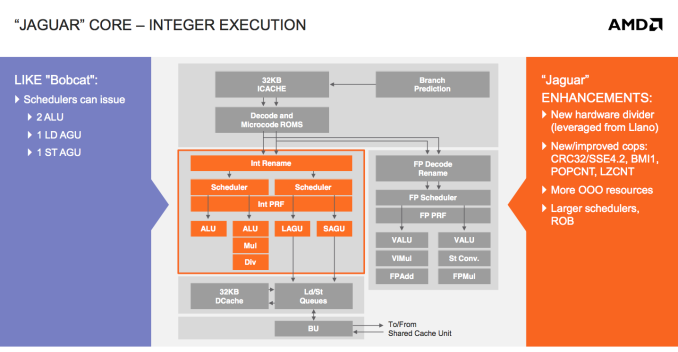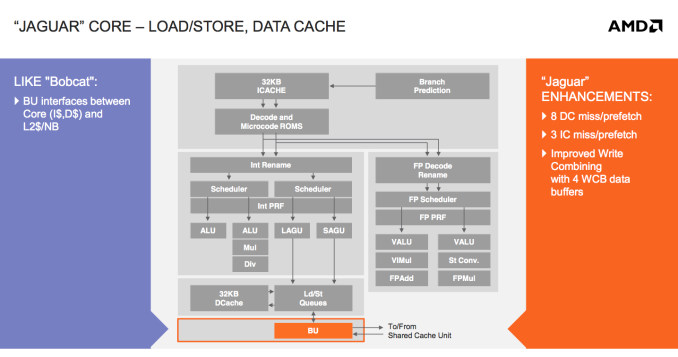AMD’s Jaguar Architecture: The CPU Powering Xbox One, PlayStation 4, Kabini & Temash
by Anand Lal Shimpi on May 23, 2013 12:00 AM ESTInteger & FP Execution
On the integer execution side, units and pipelines look largely unchanged from Bobcat. The big performance addition here is the use of Llano’s hardware divider. Bobcat had a microcoded integer divider capable of one bit per cycle, while Jaguar moves to a 2-bits-per-cycle divider. The hardware is all clock gated, so when it’s not in use there’s no power penalty.
The schedulers and re-order buffer are incrementally bigger in Jaguar. Some scheduling changes and other out of order resource increases are at work here as well.
Integer performance wasn’t a huge problem with Bobcat to begin with, but floating point performance was a different issue entirely. In our original Brazos review we found that heavily threaded FP workloads were barely faster on Bobcat than they were on Atom. A big part of that had to do with Atom’s support for Hyper Threading. AMD addressed both issues by beefing up FP execution and doubling up the maximum number of CPU cores with Jaguar (more on this later).
Bobcat’s FP execution units were 64-bits wide. Any 128-bit FP operations had to be chunked up and worked on in stages. In Jaguar, AMD moved all of its units to 128-bits wide. AVX operations complete as 2 x 128-bit operations, while all other 128-bit operations can execute without multiple passes through the pipeline. The increase in vector width is responsible for the gains in FP performance.
The move to 128-bit vectors in the FPU forced AMD to add another pipeline stage here as well. The increase in FPU size meant that some signals needed a little extra time to get from one location to the next, hence the extra stage.
Load/Store
The out-of-order load/store unit in Bobcat was the first one AMD had ever done (Bobcat beat Bulldozer to market, so it gets the claim to fame there). As such there was a good amount of room for improvement, which AMD capitalized on in Jaguar. The second gen OoO load/store unit is responsible for a good amount of the ~15% gains in IPC that AMD promises with Jaguar.














78 Comments
View All Comments
vision33r - Thursday, May 23, 2013 - link
Real shame is that AMD has not gotten into the mobile market at all. APUs like this would've been great for tablets.jeffkibuule - Thursday, May 23, 2013 - link
Even if AMD makes the chip, and OEM has to be willing to use it.duploxxx - Thursday, May 23, 2013 - link
exactly the problem, current atom is a horrible cpu in wathever device, whatever frequency you put it. have used them in notebooks and even now in a tablet. Bobcat on the other hand was awesome in the netbook range. THe temash would be way better suited for all these devices but as usual OEM focus on the blue brand with market jingles and dominancy and in the end its the end consumer (WE) that suffer from it and if it continues like this we will even suffer more. (less innovative, higher prices, dominant predefined design (something already horrible today) but many people fail to see that........as if they think there Intel system they just bought is a better suited device for everything...mganai - Thursday, May 23, 2013 - link
Intel's been going easy on AMD these past few years.Plus, Atom is finally due for its big update this year, following which we'll be seeing a more frequent update schedule in line with their Core processors.
The heterogeneous solution was what won the PS4 and XB1 for AMD.
thebeastie - Saturday, May 25, 2013 - link
Simple, Money! Why roll as fast as you can when your already the fastest and aren't going to be bringing any more money then you are now.Bobs_Your_Uncle - Saturday, May 25, 2013 - link
I'd read an interesting perspective on why Intel refrained from "kicking AMD to the curb & on down into the storm sewer" (sorry; can't recall the source). In essence, given the scope of Intel's unquestioned dominance in their chosen markets, (& mobile's on the radar), were they to act with any obvious & direct intent to further weaken, (or even try & finish off), AMD, Intel would find themselves in an extremely difficult, exceedingly complex & decidedly unpleasant set of circumstances.By decimating their only possible source of true competition, Intel would be responsible for invoking upon themselves intense anti-trust scrutiny; a result that would be inevitable assuming regulatory agencies were functioning properly.
By backing off a bit, Intel may well cede some amount of business to AMD, but they retain a legitimate market competitor & at the same time continue collecting very healthy margins. The premiums charged on sales can then be used to continue funding aggressive Intel R&D, and, uh, marketing related expenditures, too.
spartaman64 - Wednesday, June 4, 2014 - link
for a company that could "kick amd to the curb" intel is awfully nervous about amd's kaveriWolfpup - Wednesday, June 12, 2013 - link
Yeah, but regardless AMD's had the FAR better CPU now for years. I've been running the lowest end version of it for a couple of years in a tiny notebook, and from the beginning wished people were using it for tablets.Flunk - Friday, June 6, 2014 - link
When you say current Atom, are you referring to Baytrail? Previous Atoms were pretty bad for Windows boxes, in my personal experience. But the new generation is significantly more powerful (About on par with a Core 2 Duo on benchmarks). They seem pretty reasonable for basic office tasks, this may not include all the lowest-end versions.Flunk - Friday, June 6, 2014 - link
NVM, followed the wrong link and didn't see the date. Thought this was about something else. May 2013 Atoms sucked.